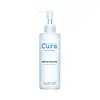What's inside
What's inside
 Key Ingredients
Key Ingredients

No key ingredients
 Benefits
Benefits

 Concerns
Concerns

 Ingredients Side-by-side
Ingredients Side-by-side

Water
Skin ConditioningGlycerin
HumectantPentylene Glycol
Skin ConditioningButylene Glycol
HumectantNiacinamide
SmoothingGluconolactone
Skin ConditioningMentha Piperita Leaf Extract
Skin ConditioningHamamelis Virginiana Leaf Extract
Skin ConditioningHouttuynia Cordata Extract
Skin ConditioningRosa Rugosa Fruit Extract
Skin Conditioning10-Hydroxydecanoic Acid
Skin ConditioningSodium Hyaluronate
HumectantSoluble Collagen
HumectantCentella Asiatica Leaf Extract
Skin ConditioningUbiquinone
AntioxidantResveratrol
AntioxidantSodium Ascorbyl Phosphate
AntioxidantMelaleuca Alternifolia Leaf Extract
PerfumingMenthoxypropanediol
MaskingAllantoin
Skin ConditioningXanthan Gum
EmulsifyingLecithin
EmollientPEG-30 Glyceryl Isostearate
PEG-50 Glyceryl Isostearate
CleansingSebacic Acid
Buffering1,10-Decanediol
SolventPentasodium Pentetate
Sodium Citrate
BufferingCitric Acid
BufferingSodium Hydroxide
BufferingPhenoxyethanol
PreservativeCitrus Aurantium Dulcis Peel Oil
MaskingWater, Glycerin, Pentylene Glycol, Butylene Glycol, Niacinamide, Gluconolactone, Mentha Piperita Leaf Extract, Hamamelis Virginiana Leaf Extract, Houttuynia Cordata Extract, Rosa Rugosa Fruit Extract, 10-Hydroxydecanoic Acid, Sodium Hyaluronate, Soluble Collagen, Centella Asiatica Leaf Extract, Ubiquinone, Resveratrol, Sodium Ascorbyl Phosphate, Melaleuca Alternifolia Leaf Extract, Menthoxypropanediol, Allantoin, Xanthan Gum, Lecithin, PEG-30 Glyceryl Isostearate, PEG-50 Glyceryl Isostearate, Sebacic Acid, 1,10-Decanediol, Pentasodium Pentetate, Sodium Citrate, Citric Acid, Sodium Hydroxide, Phenoxyethanol, Citrus Aurantium Dulcis Peel Oil
 Reviews
Reviews

Ingredients Explained
These ingredients are found in both products.
Ingredients higher up in an ingredient list are typically present in a larger amount.
Butylene Glycol (or BG) is used within cosmetic products for a few different reasons:
Overall, Butylene Glycol is a safe and well-rounded ingredient that works well with other ingredients.
Though this ingredient works well with most skin types, some people with sensitive skin may experience a reaction such as allergic rashes, closed comedones, or itchiness.
Learn more about Butylene GlycolGlycerin is already naturally found in your skin. It helps moisturize and protect your skin.
A study from 2016 found glycerin to be more effective as a humectant than AHAs and hyaluronic acid.
As a humectant, it helps the skin stay hydrated by pulling moisture to your skin. The low molecular weight of glycerin allows it to pull moisture into the deeper layers of your skin.
Hydrated skin improves your skin barrier; Your skin barrier helps protect against irritants and bacteria.
Glycerin has also been found to have antimicrobial and antiviral properties. Due to these properties, glycerin is often used in wound and burn treatments.
In cosmetics, glycerin is usually derived from plants such as soybean or palm. However, it can also be sourced from animals, such as tallow or animal fat.
This ingredient is organic, colorless, odorless, and non-toxic.
Glycerin is the name for this ingredient in American English. British English uses Glycerol/Glycerine.
Learn more about GlycerinWater. It's the most common cosmetic ingredient of all. You'll usually see it at the top of ingredient lists, meaning that it makes up the largest part of the product.
So why is it so popular? Water most often acts as a solvent - this means that it helps dissolve other ingredients into the formulation.
You'll also recognize water as that liquid we all need to stay alive. If you see this, drink a glass of water. Stay hydrated!
Learn more about Water